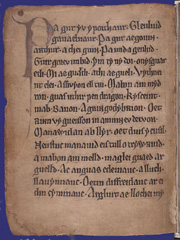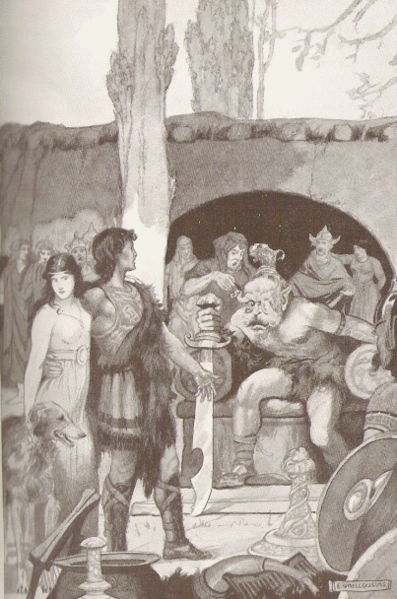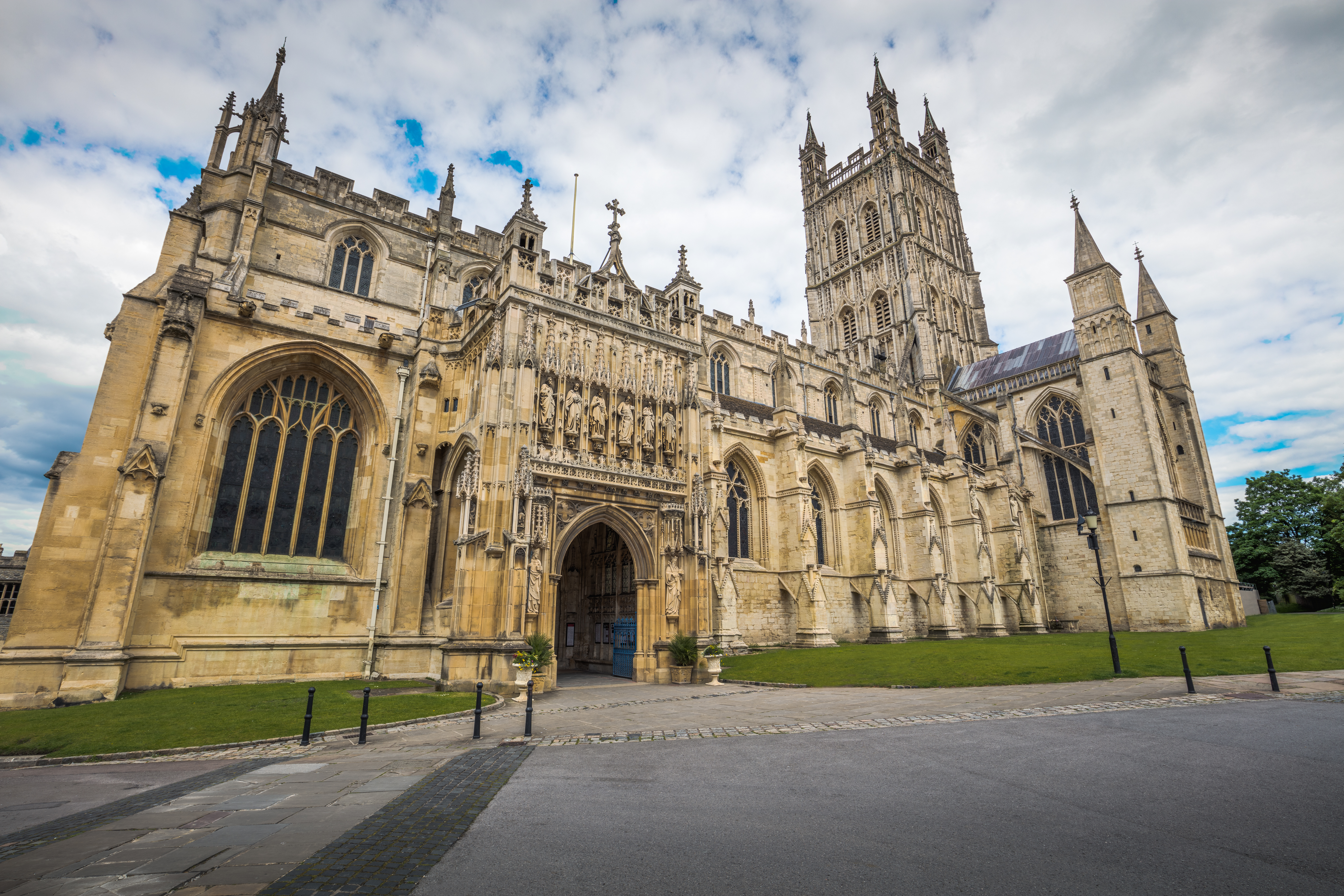|
Pa Gur
Poem 31 of the Black Book of Carmarthen, a mid-13th century manuscript, is known from its first line as ''Pa gur yv y porthaur?'' (meaning "What man is the gatekeeper?") or ''Pa gur'', or alternatively as ''Ymddiddan Arthur a Glewlwyd Gafaelfawr'' ("The dialogue of Arthur and Glewlwyd Gafaelfawr"). It is a fragmentary, anonymous poem in Old Welsh, taking the form of a dialogue between King Arthur and the gatekeeper Glewlwyd Gafaelfawr, in which Arthur boasts of his own exploits and those of his companions, especially Cai the Fair. ''Pa gur'' is notable for being one of the earliest vernacular Arthurian works, and for alluding to several early adventures of Arthur which are now lost. Its precise age is not known and has been the subject of wide-ranging disagreement, but scholarly opinion now tends to favour a date of c. 1100. Summary ''Pa gur'' is in places a very difficult text, and translations of it vary widely. This summary is based on the version of Jon B. Coe and Simo ... [...More Info...] [...Related Items...] OR: [Wikipedia] [Google] [Baidu] |
Norman Invasion Of Wales
The Norman invasion of Wales began shortly after the Norman Conquest, Norman conquest of England under William the Conqueror, who believed England to be his birthright. Initially (1067–1081), the invasion of Wales was not undertaken with the fervour and purpose of the invasion of England. However, a much stronger Norman invasion began in 1081 and by 1094 most of Wales was under the control of William's son and heir, the later King William II of England, William II. The Welsh greatly disliked the "gratuitously cruel" Normans, and by 1101, had regained control of the greater part of their country under the long reign of King Gruffudd ap Cynan, who had been imprisoned by the Normans for twelve years before his escape. In one incident, Gruffudd had some indirect help from King Magnus III of Norway (Magnus Barefoot) who attacked the Normans briefly off the Isle of Anglesey in northwest Wales near Puffin Island, Anglesey, Ynys Seiriol, killing Hugh of Montgomery, 2nd Earl of Shrewsbur ... [...More Info...] [...Related Items...] OR: [Wikipedia] [Google] [Baidu] |
Culhwch And Olwen
''Culhwch and Olwen'' () is a Welsh tale that survives in only two manuscripts about a hero connected with Arthur and his warriors: a complete version in the Red Book of Hergest, , and a fragmented version in the White Book of Rhydderch, . It is the longest of the surviving Welsh prose tales. Lady Charlotte Guest included this tale among those she collected under the title ''The Mabinogion''. Synopsis Culhwch's father, King Cilydd son of Celyddon, loses his wife Goleuddydd after a difficult childbirth. When he remarries, the young Culhwch rejects his stepmother's attempt to pair him with his new stepsister. Offended, the new queen puts a curse on him so that he can marry no one besides the beautiful Olwen, daughter of the giant Ysbaddaden Pencawr. Though he has never seen her, Culhwch becomes infatuated with her, but his father warns him that he will never find her without the aid of his famous cousin Arthur. The young man immediately sets off to seek his kinsman. He find ... [...More Info...] [...Related Items...] OR: [Wikipedia] [Google] [Baidu] |
Early Irish Literature
Early Irish literature, is commonly dated from the 8th or 9th to the 15th century, a period during which modern literature in Irish began to emerge. It stands as one of the oldest vernacular literature in Western Europe, with its roots extending back to late antiquity, as evident from inscriptions utilizing both Irish and Latin found on Ogham stones dating as early as the 4th century. The early Irish literary tradition flourished through the Medieval Irish period, and its literary output showcases a blend of indigenous storytelling, myth, and historical narratives. Notably, this period saw the development of a full-scale vernacular written literature expressed in a diverse range of literary genres. According to Professor Elva Johnston, "the Irish were apparently the first western European people to develop a full-scale vernacular written literature expressed in a range of literary genres." A significant aspect of early Irish literature is the influence of loan words from other ... [...More Info...] [...Related Items...] OR: [Wikipedia] [Google] [Baidu] |
Fianna
''Fianna'' ( , ; singular ''Fian''; ) were small warrior-hunter bands in Gaelic Ireland during the Iron Age and early Middle Ages. A ''fian'' was made up of freeborn young men, often from the Gaelic nobility of Ireland, "who had left fosterage but had not yet inherited the property needed to settle down as full landowning members of the ''túath''". For most of the year they lived in the wild, hunting, cattle raiding other Irish clans, training, and fighting as mercenaries. Scholars believe the ''fian'' was a rite of passage into manhood, and have linked ''fianna'' with similar young warrior bands in other early European cultures. They are featured in a body of Irish legends known as the 'Fianna Cycle' or 'Fenian Cycle', which focuses on the adventures and heroic deeds of the ''fian'' leader Fionn mac Cumhaill and his band. In later tales, the ''fianna'' are more often depicted as household troops of the High Kings. The Fenian Brotherhood of the 19th-century and the '' F ... [...More Info...] [...Related Items...] OR: [Wikipedia] [Google] [Baidu] |
River Ely
The River Ely () is in South Wales flowing generally southeast, from Tonyrefail to Cardiff. The river is about long. The Ely's numerous sources lie in the mountains to the south of Tonypandy, near the town of Tonyrefail, rising in the eastern slopes of Mynydd Penygraig ( Penygraig) and Mynydd y Gilfach ( Penrhiwfer) and the western slopes of Mynydd Dinas ( Williamstown), whose eastern slopes feed the Rhondda by Porth. The source of the Ogwr Fach lies just to the west. After flowing through Tonyrefail and through the grounds of the Royal Glamorgan Hospital at Ynysmaerdy, it follows the A4119 road through the valley pass formed between Mynydd Garthmaelwg, to the west and Llantrisant, to the east. Flowing through Talbot Green, the Ely is joined by the Afon Clun at Pontyclun. Although numerous smaller streams join the river, the Clun is its only large tributary. The Ely turns to the southeast on reaching the Vale of Glamorgan alongside the South Wales Main Line im ... [...More Info...] [...Related Items...] OR: [Wikipedia] [Google] [Baidu] |
Gloucester
Gloucester ( ) is a cathedral city, non-metropolitan district and the county town of Gloucestershire in the South West England, South West of England. Gloucester lies on the River Severn, between the Cotswolds to the east and the Forest of Dean to the west; it is sited from Monmouth, from Bristol, and east of the England and Wales border, border with Wales. Gloucester has a population of around 132,000, including suburban areas. It is a port, linked via the Gloucester and Sharpness Canal to the Severn Estuary. Gloucester was founded by the Roman Empire, Romans and became an important city and ''Colonia (Roman), colony'' in AD 97, under Nerva, Emperor Nerva as ''Glevum, Colonia Glevum Nervensis''. It was granted its first charter in 1155 by Henry II of England, Henry II. In 1216, Henry III of England, Henry III, aged only nine years, was crowned with a gilded iron ring in the Chapter House of Gloucester Cathedral. Gloucester's significance in the Middle Ages is unde ... [...More Info...] [...Related Items...] OR: [Wikipedia] [Google] [Baidu] |
Peredur
Peredur (, Old Welsh ''Peretur'') is the name of a number of men from the boundaries of history and legend in sub-Roman Britain. The Peredur who is most familiar to a modern audience is the character who made his entrance as a knight in the Arthurian world of Middle Welsh prose literature. Gwrgi and Peredur, sons of Eliffer Gwrgi and Peredur are listed as sons of Eliffer (Old Welsh: ''Elidir'' or ''Eleuther'') "of the great warband" (''cascord maur'') and as sons of the Coeling dynasty in the Harleian genealogies, making them first cousins of Urien.Koch, "Peredur fab Efrawg", pp. 1437–8. Likewise, a pedigree from Jesus College MS 20 includes Gwrgi and Peredur as brothers together with one Arthur ''penuchel''. Their principal claim to fame rests on their having fought in the Battle of Arfderydd. The ''Annales Cambriae'' report that this battle (''bellum Armterid'') was fought in 573, but gives no further detail.Koch, "Arfderydd", pp. 82–3. A later expansion of the entry ... [...More Info...] [...Related Items...] OR: [Wikipedia] [Google] [Baidu] |
Glamorgan
Glamorgan (), or sometimes Glamorganshire ( or ), was Historic counties of Wales, one of the thirteen counties of Wales that existed from 1536 until their abolishment in 1974. It is located in the South Wales, south of Wales. Originally an early medieval petty kingdom of varying boundaries known in Welsh as Kingdom of Morgannwg, Morgannwg (or Glywysing), which was then invaded and taken over by the Anglo-Normans, Normans as the Lordship of Glamorgan. The area that became known as Glamorgan was both a rural, pastoral area, and a conflict point between the Normans, Norman lords and the Welsh princes. It was defined by a large concentration of castles. After falling under English rule in the 16th century, Glamorgan became a more stable county, and exploited its natural resources to become an important part of the Industrial Revolution. Glamorgan was the most populous and industrialised county in Wales, and was once called the "crucible of the Industrial Revolution", as it contain ... [...More Info...] [...Related Items...] OR: [Wikipedia] [Google] [Baidu] |
Llancarfan
Llancarfan is a rural village and community in the Vale of Glamorgan, Wales. The village, located west of Barry and near Cowbridge, has a well-known parish church, the site of Saint Cadoc's 6th-century clas, famed for its learning. Cainnech of Aghaboe, Caradoc of Llancarfan and many other Welsh holy men studied there. Antiquarian Iolo Morganwg was born in the hamlet of Pen-onn near Llancarfan. At the 2001 census, the community had a population of 736. In the 2011 census, the population was 747. Most of the village lies within a conservation area designated by the local authority in 1971. Buildings listed as being of special historic interest include The Fox and Hounds public house, the former Bethlehem Chapel, the former Wesleyan Chapel, Chapel Cottage, Great House, Corner House and Llancarfan Primary School. The community includes village of Moulton. The spacious church, which in the later Middle Ages belonged to Gloucester Abbey, contains a stoup and interesting rema ... [...More Info...] [...Related Items...] OR: [Wikipedia] [Google] [Baidu] |
Cadoc
Saint Cadoc or Cadog (; also Modern Welsh: Catawg or Catwg; born or before) was a 5th–6th-century Abbot of Llancarfan, near Cowbridge in Glamorgan, Wales, a monastery famous from the era of the Celtic church as a centre of learning, where Illtud spent the first period of his religious life under Cadoc's tutelage. Cadoc is credited with the establishment of many churches in Cornwall, Brittany,''Martyrologium Romanum'', 2004, Vatican Press (Typis Vaticanis), page 529. Dyfed and Scotland. He is known as ''Cattwg Ddoeth'', "the Wise", and a large collection of his maxims and moral sayings were included in Volume III of the Myvyrian Archaiology. He is listed in the 2004 edition of the Roman Martyrology under 21 September. His Norman-era "Life" is a hagiography of importance to the case for the historicity of Arthur as one of seven saints' lives that mention Arthur independently of Geoffrey of Monmouth's ''Historia Regum Britanniae''. Biography Cadoc's story appears in a '' ... [...More Info...] [...Related Items...] OR: [Wikipedia] [Google] [Baidu] |
Patrick Sims-Williams
Patrick Sims-Williams is Emeritus Professor of Celtic Studies at Aberystwyth University and founding editor of the journal '' Cambrian Medieval Celtic Studies''. Education Sims-Williams was educated at Borden Grammar School in Sittingbourne, Kent. He took a B.A. at Trinity Hall, Cambridge, achieving upper-second-class honours in the Anglo-Saxon, Norse and Celtic tripos in 1972, followed by a PhD at the University of Birmingham. His twin brother Nicholas Sims-Williams is a scholar of Central Asia. Career Following the early retirement of the Celticist Rachel Bromwich from Cambridge's Department of Anglo-Saxon, Norse and Celtic at the end of 1976, Sims-Williams was appointed to a University Assistant Lectureship in the Department from the beginning of 1977.Michael Lapidge, 'Introduction', in ''H. M. Chadwick and the Study of Anglo-Saxon, Norse and Celtic in Cambridge'', ed. by Michael Lapidge, ''Cambrian Medieval Celtic Studies'', 69/70 (2015) , pp. 1–58. He was promoted to ... [...More Info...] [...Related Items...] OR: [Wikipedia] [Google] [Baidu] |




